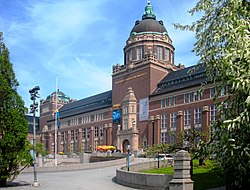Swedish Museum of Natural History
| Naturhistoriska Riksmuseet | |
|---|---|
 The Swedish Museum of Natural History | |
 | |
| General information | |
| Town or city | Stockholm |
| Country | Sweden |
| Completed | 1916 |
| Design and construction | |
| Architect(s) | Axel Anderberg |
The Swedish Royal Museum of Natural History (Swedish: Naturhistoriska riksmuseet, literally, the National Museum of Natural History), in Stockholm, is one of two major museums of natural history in Sweden,[1] the other one being located in Gothenburg.[2]
The museum was founded in 1819 by the Royal Swedish Academy of Sciences,[3] but goes back to the collections acquired mostly through donations by the academy since its foundation in 1739. These collections had first been made available to the public in 1786. The museum was separated from the Academy in 1965.[1]
One of the keepers of the collections of the academy during its earlier history was Anders Sparrman, a student of Carl Linnaeus and participant in the voyages of Captain James Cook.[4] Another important name in the history of the museum is the zoologist, paleontologist and archaeologist Sven Nilsson, who brought the previously disorganised zoological collections of the museum into order during his time as keeper (1828–1831) before returning to Lund as professor.[5]
The present buildings for the museum in Frescati, Stockholm, was designed by the architect Axel Anderberg and completed in 1916, topped with a dome. As of 2014[update] it is the largest museum building in Sweden.[1] The main campus of Stockholm University was later built next to the museum.[6]

The museum has an IMAX cinema called Cosmonova.[1] The cinema is also the largest planetarium in Sweden.[7]
References
- ^ a b c d "Naturhistoriska riksmuseet". www.sfv.se. Statens Fastinghetsverk. Archived from the original on 14 October 2014. Retrieved 17 August 2014.
{{cite web}}: Unknown parameter|deadurl=ignored (|url-status=suggested) (help) - ^ "Naturhistoriska museet". www.goteborg.com. go:teborg. Archived from the original on 19 August 2014. Retrieved 17 August 2014.
{{cite web}}: Unknown parameter|deadurl=ignored (|url-status=suggested) (help) - ^ Dahlgren, Erik Wilhelm (1915). Kungl. Svenska Vetenskapsakademien : Personförteckningar 1739–1915. Uppsala: Kungl. Svenska Vetenskapsakademien. p. 16.
{{cite book}}:|access-date=requires|url=(help) - ^ Nyberg, Kenneth (2007–2011). "Anders Sparrman". Svenskt biografiskt lexikon National Archives of Sweden (in Swedish). Vol. 33 (2007–2011). Stockholm. p. 3.
{{cite encyclopedia}}: CS1 maint: location missing publisher (link) - ^ Regnéll, Gerhard (1990–1991). "Sven Nilsson". Svenskt biografiskt lexikon National Archives of Sweden (in Swedish). Vol. 27 (1990–1991). Stockholm. p. 2.
{{cite encyclopedia}}: CS1 maint: location missing publisher (link) - ^ "Byggnader inom Frescati". www.su.se. Stockholm University. Retrieved 17 August 2014.
- ^ "Om Cosmonova". www.nrm.se. Swedish Museum of Natural History. Retrieved 17 August 2014.
External links
- 1819 establishments in Sweden
- Buildings and structures completed in 1916
- Natural history museums in Sweden
- Museums in Stockholm
- Natural history of Sweden
- Science and technology in Sweden
- Royal Swedish Academy of Sciences
- Domes
- National Museums of Sweden
- Museums established in 1819
- Art Nouveau architecture in Stockholm
- Art Nouveau museum buildings
